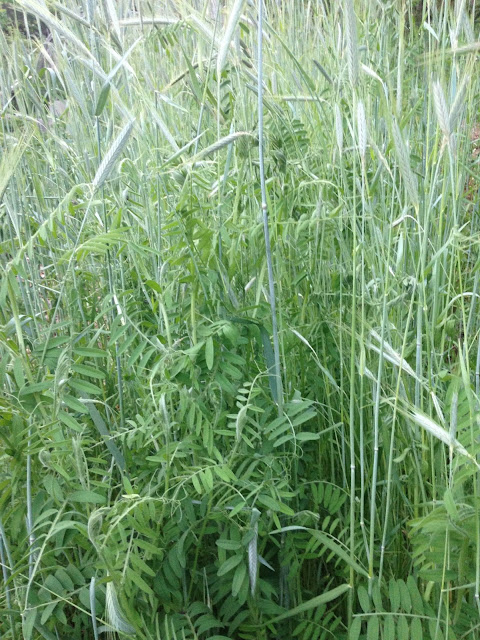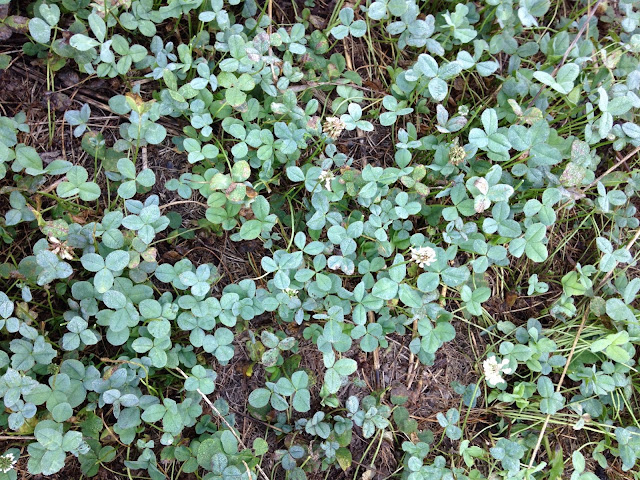By Bill Duesing
There are numerous good reasons to plant cover crops in your
garden or on your farm. And fall is the ideal time to plant cover crops.
These crops, also called green manures, grains, legumes or forage
crops, provide a wide range of benefits including:
• Great beauty
• Beneficial soil covering to control erosion
• Better understanding of the two-way relationship between plants
and soil organisms
• Weed suppression
• Healthy habitat for pollinators and other beneficial organisms
• Nitrogen production
• Compaction control, breaking up hard pan
• Pest management
• Green manure for added soil nutrients
•
Food for insects, animals and people
•
Biomass (organic matter)
•
Seeds for subsequent cover crops
•
A good way to get more carbon into the soil
Winter Rye
 |
Winter rye and hairy
vetch are often sown together in late summer. They both survive the
winter and produce lots of biomass in the spring. In addition, the rye
helps suppress weeds. New techniques using a roller-crimper are able to turn
these vigorous crops into a thick mulch.
|
Winter rye is the best known cover crop. It is an annual grain
crop that can be planted most anytime in the next several months. It grows
quickly, stays green all winter and starts growing again in the late winter.
Throughout the winter, winter rye protects the soil against erosion, and when
it photosynthesizes, it sends nutrients to feed soil organisms. (Plants feed
soil organisms. Soil organisms feed
plants.) Winter rye also has an
allopathic effect which helps control weeds.
In mid-to-late spring, rye will be a thick stand of grass about a
foot or so tall. Rye is most often
turned into the soil, after mowing, at this time to prepare for planting the
next crop. However, its extensive root
system (a benefit for soil organisms and organic matter) makes this difficult
without serious tillage equipment or a good back and shovel. I've had success mowing it and then digging a
furrow through it for planting a crop such as potatoes, while leaving the rest
as a ground covering between the rows.
In late May or June, rye starts to go to seed. If it is cut after that, it will stop growing
taller but remain green. It is then easy
to place larger plants into it (tomatoes or squash for example). If rye is cut after it is between five or six
feet tall and left in place, the straw provides a great ground covering mulch
for pumpkins or squash.
By July the rye is six to seven feet tall, a golden color with
heads full of rye seeds. The seed can be harvested for baking or eating (if you
are so inclined and careful to avoid the ergot fungus that rye is susceptible
to) or for planting several months later. That leaves a lot of wonderful straw,
those six foot tall dried stems made of slow-to-break-down, carbon-rich fiber
that is perfect for mulching, animal bedding or making compost. (John Jeavons,
author of the classic How to Grow More Vegetables, recommends planting
about three quarters of your growing area to compost crops that can provide
grains for food and stems for compost.)
Other cover crops
It is advisable to use other cover crops (besides winter rye)
throughout the year.
This helpful chart
can get you started. It lists 28 farm seed crops with information about
planting times, requisite soil temperatures, hardiness, growth rate, planting
depth and the amount to plant per 1,000 square feet or acre.
The chart also indicates the benefits of each
crop.
Here are some of my favorite cover crops used on our Old Solar
Farm over the years.
Clovers
 |
| Mammoth red clover. |
Mammoth red is the best clover for poor soils. It is very cold
tolerant and can fix up to 70 to 110 pounds of nitrogen per acre. It also is deep rooted so it loosens soils
and brings nutrients to the surface. Like all of the nitrogen-fixing legumes,
it does best if it is inoculated with the appropriate species of
nitrogen-fixing bacteria before planting. Red clover attracts bees and hummingbirds. Its flowers make a healthy
tea. I frequently leave a few of these
plants in the beds or rows. For several
years I've been experimenting with red clover mixed in the strawberry patch.
We'll see how that works.
There is also a medium red clover that is lower growing and can
be cut for hay or silage. It also can be
grown between rows of vegetables if it is mowed. This clover can fix up to 150 pounds of
nitrogen per acre, or over three pounds per 1,000 square feet!
Crimson clover has beautiful dark flowers. A winter annual, it is treated like winter
rye-planted in late summer. It starts
flowering the following May before dying back.
 |
| White clover. |
New Zealand, Dutch or other varieties of white clover are likely
the best known of the clovers. They
withstand traffic and close mowing. As a
result, they are often used between vegetable rows or beds. Before America began the destructive practice
of using chemical fertilizers and herbicides on our lawns, white clover was an
important ingredient in a lawn seed mix. It provides needed nitrogen and a deep
green color all season long.
 |
The author next to a
seven foot tall white sweet clover plant. This plant is its second year when it
provides one of the best sources of honey. Its deep roots break up compacted
soil. It also fixes nitrogen, controls erosion, suppresses weeds and
provides green manure, forage and biomass. Notice seeds along the
stems which can be collected for planting. There is also a yellow flowering
variety.
|
Sweet clover is a very tall biennial that is the source of clover
honey. See the caption above for more
information.
Hairy Vetch
For beauty it is hard to beat hairy vetch with its abundant and
beautiful bluish purple flowers. As a legume, it fixes nitrogen. It climbs up
any nearby plant or post with stems five or more feet long. Although it can occupy a lot of space, it has
a small and easy to break connection with the soil. At the Rodale Farm they use a roller-crimper
on the front of a tractor to kill the vetch and turn it into a thick
mulch. A planter on the back of the
tractor drops corn seed into a slit it's made through the vetch. That cover crop provides both nitrogen and
weed control. No chemical fertilizers or herbicides needed.
 |
Hairy vetch was
growing in many places on our farm this year. I was many times stopped
by its beauty. Hairy vetch can be planted anytime, but is most often
planted in late summer. It fixes nitrogen and the next spring and summer its
stunning purple flowers feed bees.
|
 |
At Rodale farm they use a roller crimper to turn hairy vetch
into a nitrogen rich, weed inhibiting mulch for corn which is planted by
a slit seeder in the same pass as the rolling and crimping operation.
|
Buckwheat
 |
| A quick growing crop
that can suppress weeds and feed the bees. |
Buckwheat is a beautiful, quick-growing crop that is frost
sensitive. It can be tilled in after
about a month of growth. This is
important if you don't want it to set seeds, which could be weeds in some
crops. However, I like to let it flower
because of its beauty and the great variety of insects, including honey bees,
which feed on its flowers. It is not a sturdy plant, so is easy to get rid of
if you don't want it.
Forage Radish
 |
| Forage radish in bloom. |
This is a daikon radish selected for its ability to penetrate
hard pan soils and extract nutrients. Forage radishes are planted in the late
summer and are eventually killed by several consecutive nights with
temperatures in the low 20s. It is a
daikon, so we harvest some for eating. Others we let go to seed for collecting and planting the next year. If left in the ground, the roots decompose
over the winter leaving water holding holes, a good thing.
Oats
Oats are another good cover crop grain. If planted in mid-August,
it will grow into a dense grass that lives through the first frosts before the
really cold winter weather kills it. Then it is a good thick covering for the
soil in winter which is easier to plant into than winter rye. It can also be
planted in spring for early incorporation into the soil or for grain.
Cover Crop Cocktails
 |
Winter rye and hairy vetch is a classic winter cover crop.
The vetch keeps flowering after the rye has set its seeds.
|
Many farmers are now using cover crop cocktails which combine the
benefits of many of these crops for the soil and environment. Johnny's Selected
Seeds sells spring and fall green manure mixes. The spring mix includes field
peas, oats and hairy vetch, to provide nitrogen, organic matter and weed
suppression. Their fall mix includes winter rye, field peas, ryegrass, crimson
clover and hairy vetch. Any time you plant legumes, the seed should be mixed
with an appropriate inoculant before planting.
Fedco sells a PVO soil building mix which includes field peas,
hairy vetch and oats. The oats grow first, and are pulled down by the climbing
peas before the whole is covered by the smothering vetch. This combination can
produce four tons of organic matter per acre which is disked in or mowed and
incorporated in the fall.
Now, as the leaves begin to turn and the days get shorter,
consider planting some or all of these beneficial crops on ground that is bare
or will be bare soon. Good planting to you!









